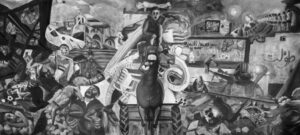[An excerpt from Rohini Mokashi-Punekar, ‘The Third Eye and Other Works: Mahatma Phule’s Writings on Education’, published by Orient BlackSwan.]
An oral and performance-based genre of poetry, the powada marked its beginning during the late seventeenth century, extolling Shivaji’s daring exploits, and had established itself by the time the Peshwas consolidated their power. As mentioned above, like the ballad in Western literature, the powada is a commemorative and celebratory form of poetry, with vivid evocations of battles and descriptions of the various victories of the chief or the warlord, as the case may be, meant to inspire valour and affinity with the ruling class. Originally performed by a Dalit community belonging to the Gondhal caste, such itinerant performances knit together the diverse populations of the Marathi-speaking region with their tales of contemporary Maratha history. The first powada according to the gazette of Maharashtra is ‘Afzal Khanacha Vadh’ performed in 1659 which describes the killing of Afzal Khan by Shivaji as a stirring act of courage and war strategy. Subsequently there were several powadas on Shivaji’s heroism commemorating his victories over the Mughal in various battles. The itinerant performances of the powadas commemorating heroes and battles and the circulation of these in the countryside was crucial, as Prachi Deshpande notes, in the creation of a shared historical memory (Deshpande 2007: 56–57). The common folk also identified with this history since the concerns of the foot soldier, who was generally a peasant when not a part of military excursions, and his world of folk religious practices were an integral part of these narrations. The lead singers/composers of the powada are known as shahirs in Marathi, and the Peshwa period is known for shahirs such as Ram Joshi, Anant Phandi and Honaji Bala who composed many powadas celebrating the military exploits of the Peshwa rulers (Nadkarni 1921: 172).
As an oral and performative genre, a great deal of improvisation marks the actual performance of the powada which factors in the specific cultural and political features of its immediate surroundings. Traditionally shahirs were known for their ability to compose almost instantaneously as they sang, each performance being a variation on certain set events or well-known historical persons. Even if written versions of powadas are available today (and they were also written down historically: perhaps records of oral performances), a shahir almost never performs from any written text; it is always an extempore performance. Powadas have starkly alternating rhythms and movements to represent the narrator/singer’s voice typically addressing different events or persons, known as chaal, rendered in my translation as ‘movement’.
Within a few decades after the end of the Peshwa rule, marking the change in the ruling dispensation, the early nationalist leaders of Maharashtra began to use the powada as a means of articulating anti-imperialist sentiments, questioning colonial power. However, Phule’s preoccupation was with the toiling masses and not with the elite aspiration for freedom. Typically, he employed the powada, as was the case with all his writings, to raise the consciousness of exploitation and oppression amongst the “lower-caste” masses. Radical as always and original in his invention of new forms or reinvention of existing literary forms, Phule is almost certainly the first person to employ the powada as a satire and an interrogation of Brahmin hegemony. Intriguingly, Phule’s reinvention of the powada has set the tradition for its deployment in post-independence India. In the 1950s shahirs such as Amar Sheikh, Annabhau Sathe and others belonging to the Communist Party of India used the powada to expose and interrogate the policies of the government. From the 1980s a new consensus between Ambedkarite forces and the left ideology has marked protests against exploitation. Sambhaji Bhagat is perhaps the most well-known contemporary shahir who sings powadas satirising imperialist globalising forces, communal politics and the age-old caste system.
Political uses of the powada
While Phule’s powada on Shivaji, titled ‘Chhatrapati Shivaji Raje Bosale yancha Powada’ where he recuperated the history of Shivaji as a non-Brahmin leader (CWMP 1991[1969]: 34–81), seems to be within the celebratory tradition of the genre, he yet commemorated this beloved Maratha king as a Shudra protector of his people, infusing into his narration the consciousness of caste identity and solidarity. However, in both ‘Brahmananche Kasab’ (‘Priestcraft Exposed’ in Phule’s English title) that presented the theme of an idyllic pre-Aryan India under the just rule of the folk king Baliraja and the destruction of this by multiple Aryan/Brahmin invasions (ibid.: 91–118) and ‘Vidyakhatyateel Brahman Pantoji’ (ibid.: 83–90), Phule deploys the form subversively for modern political purposes, interrogating power and hierarchy. It may be noted that in keeping with the traditional features of the powada, Phule does construct in ‘Brahmananche Kasab’ a historical memory. This memory, however, is not of a recent event but that of the ancient past. It builds on the hypotheses of an Aryan race and invasion, then current in emerging disciplines of comparative philology and Indology. In this powada Phule presents an alternative and subversive counter-historical memory of a harmonious pre-Aryan society destroyed by the cruelty and cunning of the invading Aryan/Brahmins.
In his third ballad, ‘Vidyakhatyateel Brahman Pantoji’ which he wrote in 1869 (henceforth ‘Brahmin Teachers in the Education Department’), Phule jettisons historicity and focuses on contemporary educational institutions and the conditions obtained therein. Structured on two complementing stanzaic forms and rhythms, this powada deftly sketches a realistic portrayal of the rural environment and its intrinsic connection to larger oppressive structures at the macro level.
Phule’s ‘Vidyakhatyateel Brahman Pantoji’
The powada opens with a moving evocation of hardworking, impoverished, “lower-caste” parents grieving over their children’s lack of access to schools and the sight of their wards at work when they ought to have been getting an education. In sharp satiric couplets, Phule contrasts their situation with the callousness of the Brahmin teacher and the village upper castes who are instrumental in driving the “Untouchable” Mahar child away, but are eager to ‘shake hands with the English’. The alternating longer stanza establishes the larger political background of the times: Brahmins reject the Shudratishudra and curry favour with the English even as they slyly instigate rebellions against the Queen. Like most subaltern leaders, Phule clearly reposes faith in the colonial government to safeguard the interests of the lower castes within the exploitative caste structure. The description of the enslavement of the Shudra and the clever positioning of the reference to the abolitionist movement in North America is meant to show the correspondences between the caste system and slavery. It is also an appeal to the colonial government asking for its understanding and support.
It is necessary to recuperate, translate and examine this powada in the present context for a number of reasons. I will list only three: First, the conditions of the nineteenth-century academic environment which Phule describes uncannily resemble the contemporary system of public education in rural India. It is crucial to examine its historical evocation if the problem is to be understood comprehensively and if these historical lacunae and the exclusions inherent in the delivery of educational policies are to be addressed with any degree of sincerity. Second, both nationalist and subaltern historiographies have erased the significant contributions of Phule’s movement on behalf of the “lower castes” and his original and radical interventions in the creation of a non-Brahmin identity in the politics and culture of his times. The reasons for the erasure may have been the perception that he is ‘soft’ and rather uncritical about exploitation resulting from the forces of imperialism. However, within the context of his times, modernity in the form of the colonial government and its secular institutions must have seemed a real alternative to Phule, disillusioned as he was by the tenacious hold of the caste structure in the minds and hearts of people. Third, the category known as Dalit literature in the last few decades is perceived, it seems to me, in curiously flattened and unhistorical terms. Phule’s literary works form a legacy that helps recuperate this rich past of interrogations and interventions. The translation is an attempt to historicise the significance of a Dalit literary past.
(Excerpt courtesy: The Wire.)




